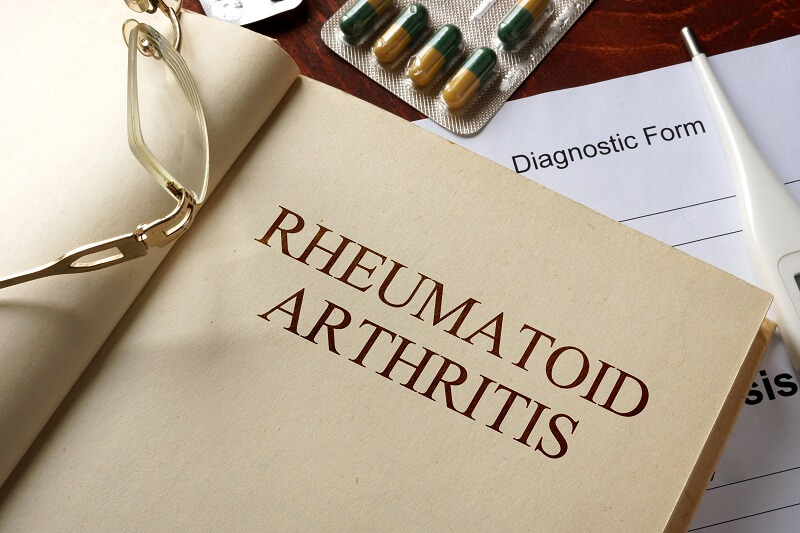WHAT IS RHEUMATOID ARTHRITIS (RA)? A QUICK SUMMARY

General: Rheumatoid arthritis (RA) is the most common autoimmune arthritis, typically affecting the hands and other joints on both sides of the body. RA can start at any age but is most commonly diagnosed between the ages of 30 and 50, and affects more women than men. RA symptoms can be severe and debilitating, leading to impairments in work, hobbies, and daily activities. Left untreated, it can lead to significant joint destruction and permanent disability. Besides the joints, RA can affect other parts of the body.
Causes: RA is an immune system disorder where the body attacks itself. There may be several contributing factors. There is a genetic association, meaning that the risk to get RA can be inherited. However, the genes may not be enough to cause rheumatoid factor. External factors like infections, as well as environmental triggers like smoking, are thought to trigger the immune system dysfunction causing RA. An inflammatory reaction occurs that affects the lining of the joint (synovium). The inflammation can also affect other parts of the body, leading to problems in the skin, eyes, heart, lungs, kidneys, and nerves.
Symptoms: RA causes pain in multiple joints, typically symmetric (in the same joints on both sides of the body). It is most commonly found in the smaller joints of the hands and wrists, and can also occur in most other joints throughout the body. However, it does not affect the fingertip joints or lower back. There is joint stiffness, especially in the morning lasting longer than one hour after awakening. Jjoint swelling, called synovitis, with redness and tenderness can occur, especially during RA flare-ups.
RA can also cause general symptoms that include fatigue and fevers. In many patients RA affects other parts of the body, such as the skin, eyes, heart, lungs, kidneys, and nerves:
- Rheumatoid nodules can form in the skin adjacent to bony prominences.
- Eye changes can range from pain and redness to Sjogrens-like dryness.
- Lung disease can occur
- Inflammation can develop around the heart (pericarditis).
- Nerve problems can develop, such as carpal tunnel syndrome.
RA symptoms can vary from mild to severe, or can progress and worsen over time. Flareups may occur from time to time that cause a temporary increase in symptoms. Over time, especially if left untreated, the immune system attack on the synovial joint linings can lead to profound destruction and deformities in the joints.
Dx: Early diagnosis is essential for controlling symptoms and minimizing long term joint damage.
Physical examination will typically reveal tenderness, inflammation, and stiffness in joints , especially in the hands. The pattern is usually symmetric (same joints affected on both sides of the body).
Blood tests are helpful. General testing like erythrocyte sedimentation rate (ESR) and C-reactive protein (CRP) can detect inflammation to confirm that there is immune system dysfunction. Rheumatoid factor (RF) and/or anti-citrullinated (ACPA) antibodies are found in most patients with RA. Liver, kidney,and bloodcell testing can reveal associated rheumatoid arthritis- related problems.
X-rays are helpful in diagnosing rheumatoid arthritis when joint destruction has begun, but may be normal in early stages of the disease.
Sometimes, rheumatoid arthritis is difficult to diagnose because clinical findings and testing can vary. In such cases, rheumatologists use a scoring system established by the American College of Rheumatology, or will make the diagnosis based on their overall assessment of a patient’s overall findings.
Treatment: Rheumatoid arthritis is treatable and can be controlled, and also can go into remission. Therefore, it is important to treat the disease aggressively with the goals of treating symptoms in the short term, while decreasing long-term complications.
Disease-modifying antirheumatic drugs (DMARDs) are considered the first-line treatments for RA. Of these, methotrexate is a nonbiologic agent considered the medication of choice, but cannot be used in patients with liver disease or alcohol abuse. Other nonbiologic DMARDs include sulfasalazine and hydroxychloroquine. There is a newer class of biologic DMARDs that are effective as well. These medications target specific components of immune system dysfunction in RA, but are known to increase risk of infections. Several medications are available and in development.
Corticosteroids are useful for controlling inflammation, especially for flare-ups and severe ongoing symptoms, but should be limited because of severe side effects with long-term use.
Although methotrexate can lead to remission in up to 75% of patients with RA, other DMARDs may have to be used instead or in combination.
With biologic DMARDs, there is risk of tuberculosis (TB) activation, so regular screening must be done. TB is a severe infectious lung disease. Biologic DMARDs must be used with caution in patients with heart disease. These medications may also increase risk of skin cancer, so regular skin checks should be conducted by a qualified physician.
Once RA has gone into a sustained remission, rheumatologists may decrease or discontinue R medications and then monitor patients closely for recurrent symptoms or flare-ups.
Complications: There are a number of complications that may occur in association with RA. Joint destruction over time can lead to severe, debilitating loss of function. Ongoing orthopedic treatment may be needed, ranging from home treatments, injections, physical therapy, or surgery. Joint replacement surgery may be required, most commonly in the hip or knee.
RA is associated with an increased risk of lymphoma. Meanwhile, RA medications may increase risk of skin cancer or tuberculosis, and prolonged immune system suppression may increase risk of various infections.
Self-management: Many home treatments can supplement medical treatments. Lifestyle management can dramatically reduce symptoms and improve/maintain well-being and quality of life. Healthy diet focused on anti-inflammatory foods, stress reduction techniques, activity modifications, rest, heat/ice treatments, and social support have all been shown to be helpful. Various dietary supplements can be used, but can be controversial.
Other Topics That Interest You


